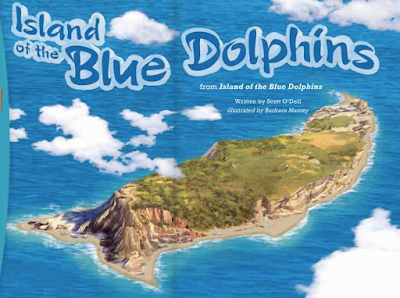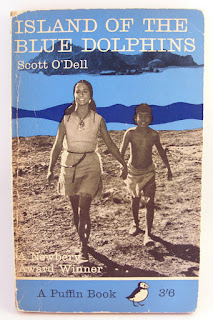 |
| Scott O'Dell wrote a famous fictional account of what happened. Here is Karana's true story. |
 |
| San Nicolas Island off the California coast (islandconservation/flickr.com) |
The history of California's Native American "Juana Maria" (inspiration for Island of the Blue Dolphin), produced by an unnamed fourth grader with commentary, ancient Chumash recordings, and scenes from the Santa Barbara Mission and Natural History Museum.
 |
| L.A./Channel Islands: 65 miles out to sea |
The most famous Native American (Tongva) islander in Southern California lived on one of the Channel Islands just beyond Los Angeles. The fiction writer Scott O'Dell called this "Lone Woman of San Nicolas Island" Karana.
- She was later christened Juana Maria by Anglo Christian missionaries in the Santa Barbara Mission. When first abducted, she escaped back to the island by jumping ship to get her brother, who was later eaten by wild dogs, as the rest of the native Ghalas-at people (called Nicoleños) were moved from San Nicolas Island to mainland California. She survived on the island alone with dogs for 18 years, likely seeing others who passed. In 1853 Capt. Nidever and his crew "rescued" her and took her to Santa Barbara. Her story is told in Island of the Blue Dolphins ("With island dig halted, Lone Woman still a stinging mystery," Los Angeles Times, 3-5-15).
(Lainee Tuemer) Karana's story in a nutshell from Scott O'Dell's book Island of the Blue Dolphins
Better-than-Nothing
The Strange Tale of the Lone Woman of San Nicolas Island
 |
| Off the coast of Los Angeles are eight large Channel Islands, such as Catalina (wiki). |
 |
| "Karana" (Braun Library, Autry Nat'l Center, LA) |
It was 1853 on San Nicolas Island, the most remote of California's eight Channel Islands.
Sixty-five miles southwest of Point Mugu, in Ventura County, one visitor reported:
The island's "shifting sand dunes, its 90-foot fog shrouded peak, its deep cut canyons, its bleak cliffs, and the crashing seas breaking over its rocky shores" made it "just about one of the most desolate places on earth."
The island's "shifting sand dunes, its 90-foot fog shrouded peak, its deep cut canyons, its bleak cliffs, and the crashing seas breaking over its rocky shores" made it "just about one of the most desolate places on earth."
This isolated isle had once been home to a thriving group of native people known [to invaders who renamed the island Saint Nicolas Island] as the Nicolenos.
- Five of the eight Channel Islands are part of Channel Islands National Park. The waters surrounding them make up California's Channel Islands National Marine Sanctuary. They were first inhabited by the Los Angeles area Tongva and Ventura Chumash Native Americans 13,000 years ago, who were then killed by European colonialists. The US military now uses the islands as weapons test sites, training grounds, and strategic defense much in the way they have overtaken and ruined the massive Hawaiian island chain, the majority of which is closed to civilians.
- Hawaii encompasses most of the volcanic Hawaiian archipelago, hundreds of islands spread over 1,700 miles.
 Now it was supposedly uninhabited, though sailors sailing by occasionally reported seeing a human figure waving her arms, running towards them on the foggy shore.
Now it was supposedly uninhabited, though sailors sailing by occasionally reported seeing a human figure waving her arms, running towards them on the foggy shore.In 1853, Captain George Nidever set out on his third trip in search of this legendary apparition. The year before, his crew had discovered footprints in the sand.
This time, they found what they were looking for near three whalebone huts in a clearing among the sand dunes. Crewman Carl Dittman recalled the moment of discovery:
.
"She was seated cross legged on the ground and was engaged in separating the blubber from a piece of seal skin which was lying across one knee and held by one hand. In the other hand she grasped a rude knife, a piece of iron hoop thrust into a rough piece of wood for a handle...."Outside there was a high pile of ashes and bones showing that she had lived in this place for some time. Baskets of grass and vessels of the same material made in the shape of a flagon and lined with asphaltum, used to hold water, were scattered about.
 |
| San Nicolas: rocky, desolate, full of seals, surrounded by dolphins and sharks |
.
 |
| Karana ("Juana Maria") survived alone. |
"On a sinew rope stretched between two poles several feet above the ground were hanging pieces of seal blubber, while near her was the head of a seal from which the brains already putrid were running.
The discovery of the lone woman put an end to a speculative mystery that had brewed in coastal California for 18 years. But as was often the case for native people in the "new world," her "discovery" would soon lead to her death.
The Nicoleno tribe lived and flourished on San Nicolas Island for around 8,000 years. In fact, the huge number of town sites scattered across the three-by-nine mile isle have led some archeologists to speculate that it may have been a vacation spot for other Native American groups from the mainland.
The Nicolenos were seafaring people, using canoes [ti'at] to trade with neighboring tribes like the Tongva (Gabrielinos of Los Angeles) and the Chumash....
What happened to Karana?
Although no one could understand the language Karana spoke, she talked and sang incessantly and was an adept singer.
Crewmen were impressed with her resourcefulness: she kept every scrap of food she could, saving bones so that she could suck them to the marrow.
She helped the visitors find fresh water and firewood and showed Nidever how to make a water proof jug using heated stones and asphaltum.
When it was time to leave, she boarded the ship willingly, her clothes and one filled large basket the only remnants of her former life.
She was taken to Mission Santa Barbara and placed in the care of Nidever's wife. She was a regional curiosity, and folks came from far and wide to see her sing and dance. Capt. Nidever was offered a chance to display her as a circus sideshow, which he declined.
After many years alone, she seemed thrilled to be with people once again. She was fascinated by the new sights and sounds around her.
When she saw a man on a horse for the first time, she thought they were one creature. She was so amazed when the rider dismounted that she had to go over and touch them both.
 All of her kinfolk were dead by this time, and none of the other Native Americans or multi-lingual European priests at the mission were able to understand her. But her kindness was evident to everyone.
All of her kinfolk were dead by this time, and none of the other Native Americans or multi-lingual European priests at the mission were able to understand her. But her kindness was evident to everyone.
She was continually given gifts by visitors which she would accept effusively and then give to the Nidever children.
Only a few weeks after she was left at the Catholic mission, Karana died. Though her death was blamed on an overindulgence of rich food, a simple illness (dysentery) that she had no immunity to was probably the real cause.
In a final insult, after her death, the woman was baptized in the Catholic faith and Christened "Juana Maria." She was buried at the Santa Barbara mission in an unmarked grave as was the custom then. More
What happened to Karana?
 |
| Forget Karana, Juana Maria monument |
Crewmen were impressed with her resourcefulness: she kept every scrap of food she could, saving bones so that she could suck them to the marrow.
She helped the visitors find fresh water and firewood and showed Nidever how to make a water proof jug using heated stones and asphaltum.
When it was time to leave, she boarded the ship willingly, her clothes and one filled large basket the only remnants of her former life.
She was taken to Mission Santa Barbara and placed in the care of Nidever's wife. She was a regional curiosity, and folks came from far and wide to see her sing and dance. Capt. Nidever was offered a chance to display her as a circus sideshow, which he declined.
After many years alone, she seemed thrilled to be with people once again. She was fascinated by the new sights and sounds around her.
When she saw a man on a horse for the first time, she thought they were one creature. She was so amazed when the rider dismounted that she had to go over and touch them both.
 All of her kinfolk were dead by this time, and none of the other Native Americans or multi-lingual European priests at the mission were able to understand her. But her kindness was evident to everyone.
All of her kinfolk were dead by this time, and none of the other Native Americans or multi-lingual European priests at the mission were able to understand her. But her kindness was evident to everyone.She was continually given gifts by visitors which she would accept effusively and then give to the Nidever children.
Only a few weeks after she was left at the Catholic mission, Karana died. Though her death was blamed on an overindulgence of rich food, a simple illness (dysentery) that she had no immunity to was probably the real cause.
In a final insult, after her death, the woman was baptized in the Catholic faith and Christened "Juana Maria." She was buried at the Santa Barbara mission in an unmarked grave as was the custom then. More


































































































































































































































No comments:
Post a Comment